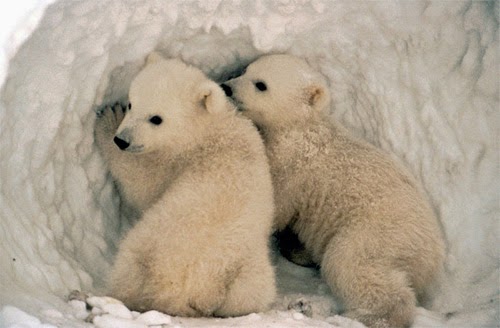Polar Bear
Polar bears are marine mammals and are
large, white bears that like cold climates. They are the largest land predators
in the world. They can weigh up to 1500 pounds and are twice as large as a
lion. Polar bears can be up to 10 feet long. The polar bear is a carnivorous bear. Polar bears are good
swimmers.

Although
polar bears look cuddly and nice, they are very dangerous and aggressive. They
often wrestle to practice fighting with each other, but rarely actually hurt
each other. A mother will staunchly defend her cubs, so don't go anywhere near
a mother and her cubs.
A Polar Bear's Diet
Polar bears hunt on land and on sea.
They are comfortable in the icy water and swim with their front paws similar to
dogs. Seals are the polar bear's main source of food, but polar bears eat all
sorts of things including small animals and berries. Polar bears will often
hide by a hole in the ice where seals come up for air. When the seal comes up
for air, the polar bear will grab the seal with its sharp claws.
Females usually give birth during the months of November or December, after a gestation of eight months. In preparation, the animals dig a cave from a snow bank in which to have their cubs. This cave is called a maternity den.
Polar bear babies are called cubs. They
are born in the winter. When first born, a polar bear cub weighs only 1 pound.
It can't hear or see and has very little fur. Cubs will stay with their mother
for a few years and she will teach them how to hunt and forage for food.
A female polar bear typically gives
birth to twins, though singles and triplets have been recorded. Cubs depend on
their mothers for warmth and fattening milk. By spring, the cubs are outside
the den, exploring, and at two years of age they are fully mature. Polar bears
live around 15 to 20 years.
 | ||
| Polar Bear Mother and her Cubs |
 |
| Polar Bear Cubs |
 |
| Polar Bears Play Fight |
 |
| Polar Bear Swimming |
Fun Facts
about Polar Bears
- They can see great under water.
- The fur of a polar bear isn't actually white, but is actually clear tubes of hair that make them look white.
- They are patient and will wait for hours above a seal hole for a chance to catch dinner.
- They have a great sense of smell and can smell a seal that is up to 20 miles away.
- They don't hibernate, but they do stay warm in the winter by sleeping in a den.
- They have been known to go on long swims of over 100 miles.
- They are at the top of the food chain in their environment.
No comments:
Post a Comment